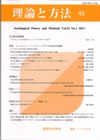Volume 21, Issue 2
Displaying 1-14 of 14 articles from this issue
- |<
- <
- 1
- >
- >|
Special Articles
-
2006 Volume 21 Issue 2 Pages 165-166
Published: September 30, 2006
Released on J-STAGE: March 27, 2009
Download PDF (98K) -
Article type: Special Article
2006 Volume 21 Issue 2 Pages 167-182
Published: 2006
Released on J-STAGE: August 02, 2007
Download PDF (301K) -
2006 Volume 21 Issue 2 Pages 183-198
Published: September 30, 2006
Released on J-STAGE: August 02, 2007
Download PDF (281K) -
2006 Volume 21 Issue 2 Pages 199-214
Published: September 30, 2006
Released on J-STAGE: August 02, 2007
Download PDF (247K)
Symposium : Frontiers of Social Stratification Research
-
Article type: Symposium
2006 Volume 21 Issue 2 Pages 215-236
Published: 2006
Released on J-STAGE: August 02, 2007
Download PDF (170K) -
2006 Volume 21 Issue 2 Pages 237-252
Published: September 30, 2006
Released on J-STAGE: August 02, 2007
Download PDF (409K) -
2006 Volume 21 Issue 2 Pages 253-278
Published: September 30, 2006
Released on J-STAGE: August 02, 2007
Download PDF (210K)
Articles
-
2006 Volume 21 Issue 2 Pages 279-294
Published: September 30, 2006
Released on J-STAGE: August 02, 2007
Download PDF (157K) -
2006 Volume 21 Issue 2 Pages 295-312
Published: September 30, 2006
Released on J-STAGE: August 02, 2007
Download PDF (253K) -
2006 Volume 21 Issue 2 Pages 313-332
Published: September 30, 2006
Released on J-STAGE: August 02, 2007
Download PDF (411K)
Research Note
-
2006 Volume 21 Issue 2 Pages 333-342
Published: September 30, 2006
Released on J-STAGE: August 02, 2007
Download PDF (170K)
Book Reviews
-
2006 Volume 21 Issue 2 Pages 343-355
Published: September 30, 2006
Released on J-STAGE: March 27, 2009
Download PDF (355K)
Errata
-
2006 Volume 21 Issue 2 Pages 357_e1
Published: September 30, 2006
Released on J-STAGE: March 27, 2009
Download PDF (69K) -
2006 Volume 21 Issue 2 Pages 357_e2
Published: September 30, 2006
Released on J-STAGE: March 27, 2009
Download PDF (69K)
- |<
- <
- 1
- >
- >|
